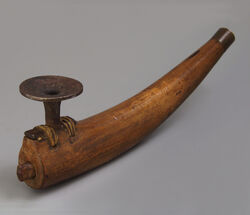From the cold north
October 2021

The culture of the Inuit in Alaska is characterized by scarcity and simplicity. It is about a people that has little material possessions and because of the climate has to do without a lot of things. Pipe smoking is a pleasant pastime in Alaska, although it was a luxury for a long time. Obviously, tobacco was imported, so it was scarce and used sparingly. The tobacco pipes of the Inuit are also like that. A distinctive feature is the small pipe bowl that is standard surrounded by a disk shape. When filling and cleaning the pipe, this disk ensures that the tobacco crumb does not fall out and gets lost. After smoking, the ashes are even sifted on usable tobacco threads. The design of this simple wooden pipe is borrowed from walrus tusk counterparts. In that prototype, a separate pipe bowl is placed on a piece of tooth that serves as a stem. The thickest part is under the bowl, the tooth runs towards the mouthpiece, completely in its natural shape. The slightly upward curvature of the stem is therefore also based on the bent shape of the walrus tusk. That stereotypical design has remained unchanged with this wooden specimen. The pipe bowl itself could not be made of wood, wrought iron was chosen here. This was made as a commodity by a local blacksmith, maybe not even in Alaska but further away. The metal pipe bowl is attached to the stem with simple leather stitching. Piercing the stem was a separate issue. This was done from the two ends, halfway up the stem where the two smoke tubes meet, there is even an opening, sealed with a wooden lid. There is a wooden plug under the bowl, which closes the end of the smoke tube. By removing both pieces of wood, the smoker was able to clean his pipe properly. The bone mouthpiece got lost over time. In its simple appearance, this is a beautiful piece of ethnographic smoking utensil.
Amsterdam Pipe Museum APM 24.295
Permalink